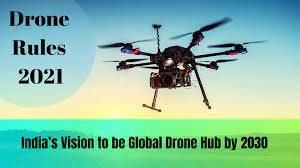CURRENT AFFAIRS
Get the most updated and recent current affair content on Padhaikaro.com
Drone Rules, 2021
- IAS NEXT, Lucknow
- 05, Feb 2022

Reference News:-
As on 31 December 2021, nine remote pilot training organisations have been set up by entities under Government or private ownership.
- As per Drone Rules, 2021, any person who intends to obtain the authorisation to establish a Remote Pilot Training Organisation (RPTO) shall submit an application to the Director General of Civil Aviation in Form D5 on the Digital Sky Platform, along with the specified fees.
Drone management in India:
- The Union government had on September 15 approved a production-linked incentive (PLI) scheme for drones and drone components with an allocation of Rs 120 crore spread over three financial years.
- The ministry had on August 25 notified the Drone Rules, 2021 that eased the regulation of drone operations in India by reducing the number of forms that need to be filled to operate them from 25 to five and decreasing the types of fees charged from the operator from 72 to four.
New drone rules:
- Digital sky platform shall be developed as a business-friendly single-window online system.
- No flight permission required upto 400 feet in green zones and upto 200 feet in the area between 8 and 12 km from the airport perimeter.
- No pilot licence required for micro drones (for non-commercial use), nano drones and for R&D organisations.
- No restriction on drone operations by foreign-owned companies registered in India.
- Import of drones and drone components to be regulated by DGFT.
- No security clearance required before any registration or licence issuance.
- No requirement of certificate of airworthiness, unique identification number, prior permission and remote pilot licence for R&D entities.
- Coverage of drones under Drone Rules, 2021 increased from 300 kg to 500 kg. This will cover drone taxis also.
- Issuance of Certificate of Airworthiness delegated to Quality Council of India and certification entities authorised by it.
- Manufacturer may generate their drone’s unique identification number on the digital sky platform through the self-certification route.
- Maximum penalty under Drone Rules, 2021 reduced to INR 1 lakh. This shall, however, not apply to penalties in respect of violation of other laws.
- Drone corridors will be developed for cargo deliveries.
- Drone promotion council to be set up to facilitate a business-friendly regulatory regime.
Need for stricter rules and regulations:
- Recently, Drones were used for the first time to drop explosive devices, triggering blasts inside the Air Force Station’s technical area in Jammu.
- Over the past two years, drones have been deployed regularly by Pakistan-based outfits to smuggle arms, ammunition and drugs into Indian territory.
- According to government figures, 167 drone sightings were recorded along the border with Pakistan in 2019, and in 2020, there were 77 such sightings.
- With the rapid proliferation of drone technology and exponential growth of its global market in recent years, the possibility of a drone attack cannot be ruled out even in the safest cities in the world.
- Drones are becoming security threats particularly in conflict zones where non-state actors are active and have easy access to the technology.
Drone Categories in India:
Registration is required for all but the Nano category.
- Nano: Less than or equal to 250 grams
- Micro: From 250 grams to 2kg
- Small: From 2kg to 25kg
- Medium: From 25kg to 150kg
- Large: Greater than 150kg
Significance of Drones:
- Use of drones in commercial, safety, law and order, disaster management and surveillance operations reduce manpower requirement and costs.
- Drones offer low-cost, safe and quick aerial surveys for data collection and are useful for industries such as power, mining, realty and oil and gas exploration.